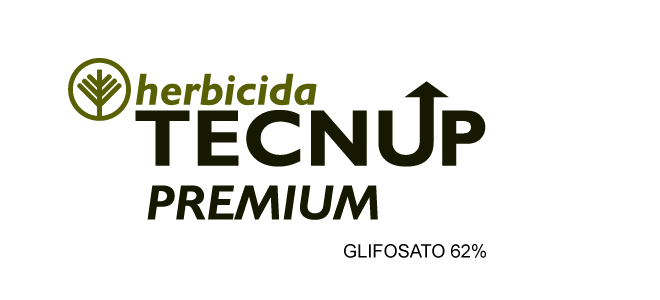

Composition:
| Glyphosate potassium acid salt -[N- (phosphonomethyl) glycine] | 62 % (w/v) |
| Inerts | 38 % (w/v) |
Remark: The equivalent of the salt is 50.6%.
Chemical group:
GLYCINE DERIVATIVES.
Formulation:
SOLUBLE CONCENTRATE (SL).
Overview:
TECNUP PREMIUM is a glyphosate specially developed by TECNOMYL S.A. to be used in the prior desiccation of all crops and for post-emergence of RR soybeans, its use allows to increase the speed of weed control, making it possible to anticipate the sowing time, it adapts perfectly to the mixtures made with the products of common use (Herbicides, Insecticides and Fungicides). Its rapid penetration and translocation within the plant, allows it to be more efficient than common glyphosates on weeds that are difficult to control (except those declared resistant to glyphosate). Its new formulation allows to use lower doses/ha obtaining better results.
Application method:
It can be applied in air and land pulverizations using back pulverizer, power-driven or tractor boom sprayers with the adequate spikes. Is not necessary to add oi, moisturizers or pH correctors.
Phytotoxicity and compatibility:
Is compatible with most of the phytosanitary products of common use, except the ones of strong alkaline reaction. Always run prior tests of physical compatibility for mixtures with emulsifiable concentrates. Does not affect the crops due to the presence of phytotoxic residues in the soil. Drift mists can cause irreversible damage to nearby crops, mainly grasses (cereals, sugar cane, lawn, pastures).
Re-entry time to the area of treatment:
12 hours. In case the re-entry is necessary before term, do it by employing personal protective equipment.
Toxicological class:
Class IV – Green Stripe.
Antidote:
Does not possess.
Packaging:
Containers of 20 Lts.
Directions for use:
Weeds:
Annual grasses with less than 4 tillers and broadleaves with less than 12 leaves.
Dose: 1,4 – 1,8 l/ha
Weeds:
Annual grasses with more than 4 tillers and broadleaves with more than 12 leaves.
Dose: 1,7 – 2,6 l/ha
Weeds:
Underdeveloped perennial grasses.
Dose: 2,0 – 2,6 l/ha
Weeds:
Developed perennial grasses.
Dose: 3,0 – 4,0 l/ha
Weeds:
Underdeveloped perennial broadleaves.
Dose: 3,0 – 4,0 l/ha
Weeds:
Developed perennial broadleaves and sedges.
Dose: 3,5 – 4,5 l/ha
Weeds:
Annual grasses with less than 4 tillers and broadleaves with less than 12 leaves.
Dose: 1,4 – 1,8 l/ha
Weeds:
Annual grasses with more than 4 tillers and broadleaves with more than 12 leaves.
Dose: 1,7 – 2,6 l/ha
Weeds:
Annual grasses with less than 4 tillers and broadleaves with less than 12 leaves.
Dose: 1,4 – 1,8 l/ha
Weeds:
Annual grasses with less than 4 tillers and broadleaves with more than 12 leaves.
Dose: 1,7 – 2,6 l/ha
Weeds:
Underdeveloped perennial grasses.
Dose: 2,0 – 2,6 l/ha
Weeds:
Developed perennial grasses.
Dose: 3,0 – 4,0 l/ha
“Underdeveloped” are the weeds smaller than 12 cm (average) and “developed” are those greater than 12 cm in height. TECNUP PREMIUM can be mixed with pre-emergent herbicides.
In desiccation:
– For wheat: it can be mixed with Metsulfuron or 2,4D for control of creepers and Santa Lucia weeds.
– For rice: it can be mixed with 2,4D or Metsulfuron for control of sedges and broad leaves in general.
– For corn it can be mixed with 2,4D for general broadleaves control.
– For soybeans: can be mixed with chlorimuron (up to 80 g/ha) for control of creeper species or Zethapyr (for residual control of “creeper” and “Santa Lucia” weeds), its mixture with 2,4-D AMINA TECNOMYL improves the Conyza spp «buva» (resistant) control and its mixture with Todym improves the population control of Digitaria insularis «kapi’i pororo» (resistant). It can be mixed with “Supermyl or Clorfos” for control of early plagues and soil.
In Post-emergence:
– Of RR Soybean: It can be applied throughout the entire cycle since it is very selective and adapts to mixtures with commonly used insecticides and fungicides.
Starbur / Acanthospermum australe
Bristly starbur / Acanthospermum hispidum
Ageratum / Ageratum conyzoides
Green Amaranth / Amaranthus hybridus
Slender Amaranth / Amaranthus viridis
Bristle Oats / Avena strigosa
Cobbler’s Peg / Bidens pilosa
Marmelade grass / Brachiaria plantaginea
Southern Sandbur / Cenchrus echinatus
Asthma Weed / Chamaesyce hirta
Lamb’s quarter / Chenopodium album
Fragrant flatsedge / Cyperus ferax
Fierce Thorn Apple / Datura ferox
Crabgrass / Digitaria horizontalis
Barnyard Grass / Echinochloa crus-galli
Goosegrass / Eleusine indica
Red Tasselflower / Emilia sonchifolia
Wild Spurge / Euphorbia heterophylla
Gallant Soldier / Galinsoga parviflora
Hairy Indigo / Indigofera hirsuta
Common Morning Glory / Ipomoea aristolochiaefolia
Klip Daga / Leonotis nepetifolia
Siberian motherwort / Leonurus sibiricus
Raigrás criollo / Lolium multiflorum
False Mallow / Malvastrum coromandelianum
Wild Buckwheat / Polygonum convolvulus
Radish / Raphanus raphanistrum
White-eye / Richardia brasiliensis
Green Foxtail / Setaria spp
Heart-leaf Sida / Sida cordifolia
Arrow-leaf sida / Sida rhombifolia
Common Milk thistle / Sonchus oleraceus
Carb White / Alternanthera tenella
Palisade Grass / Brachiaria brizantha
Signal Grass / Brachiaria decumbens
Horseweed / Conyza bonariensis
Bermuda Grass / Cynodon dactilon
Purple nutsedge / Cyperus rotundus
Chufa Flatsedge / Cyperus esculentus
Sourgrass / Digitaria insularis
Guineagrass / Panicum maximum
Buffalo Grass / Paspalum conjugatum
Bahia Grass / Paspalum notatum
Russell-river Grass / Paspalum paniculatum
Common Knotgrass / Polygonum aviculare
Curly dock / Rumex crispus
Sugarcane / Saccharum officinarum
Aleppo Grass / Sorgum halepense
WP: Waiting Period – Does not have
Downloads
243 KB


